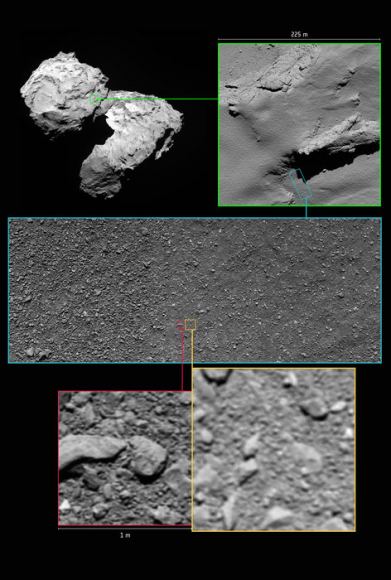ESA scientists have found one additional image from the Rosetta spacecraft hiding in the telemetry. This new image was found in the last bits of data sent by Rosetta immediately before it shut down on the surface of Comet 67P/Churyumov–Gerasimenko last year.
The new image shows a close-up shot of the rocky, pebbly surface of the comet, and looks somewhat reminiscent of the views the Huygens lander took of the surface of Saturn's moon Titan.

A final image from Rosetta, shortly before it made a controlled impact onto Comet 67P/Churyumov–Gerasimenko on 30 September 2016. Credit: ESA/Rosetta/MPS for OSIRIS Team MPS/UPD/LAM/IAA/SSO/INTA/UPM/DASP/IDA.
The picture has a scale of 2 mm/pixel and measures about 1 m across. It's a really 'close' close-up of Comet 67P.
"The last complete image transmitted from Rosetta was the final one that we saw arriving back on Earth in one piece moments before the touchdown at Sais," said Holger Sierks, principal investigator for the OSIRIS camera at the Max Planck Institute for Solar System Research in Göttingen, Germany. "Later, we found a few telemetry packets on our server and thought, wow, that could be another image."
The team explains that the image data were put into telemetry 'packets' aboard Rosetta before they were transmitted to Earth, and the final images were split into six packets. However, for the very last image, the transmission was interrupted after only three full packets. The incomplete data was not recognized as an image by the automatic processing software, but later, the engineers in Göttingen could make sense of these data fragments to reconstruct the image.
You'll notice it is rather blurry. The OSIRIS camera team says this image only has about 53% of the full data and "therefore represents an image with an effective compression ratio of 1:38 compared to the anticipated compression ratio of 1:20, meaning some of the finer detail was lost."
That is, it gets a lot blurrier as you zoom in compared with a full-quality image. They compared it to compressing an image to send via email, versus an uncompressed version that you would print out and hang on your wall.
Rosetta's final resting spot is in a region of active pits in the Ma'at region on the two-lobed, duck-shaped comet.

A montage of the last few images from Rosetta, including the new image, with context of where the features on the last images are located. Credit: ESA/Rosetta/MPS for OSIRIS Team MPS/UPD/LAM/IAA/SSO/INTA/UPM/DASP/IDA
Launched in 2004, Rosetta traveled nearly 8 billion kilometers and its journey included three Earth flybys and one at Mars, and two asteroid encounters. It arrived at the comet in August 2014 after being in hibernation for 31 months.
After becoming the first spacecraft to orbit a comet, it deployed the Philae lander in November 2014. Philae sent back data for a few days before succumbing to a power loss after it unfortunately landed in a crevice and its solar panels couldn't receive sunlight.
But Rosetta showed us unprecedented views of Comet 67P and monitored the comet's evolution as it made its closest approach and then moved away from the Sun. However, Rosetta and the comet moved too far away from the Sun for the spacecraft to receive enough power to continue operations, so the mission plan was to set the spacecraft down on the comet's surface.
And scientists have continued to sift through the data, and this new image was found. Who knows what else they'll find, hiding the data?
Read more details about this image at ESA's website.
Read our article about Rosetta's mission end here.
No comments:
Post a Comment